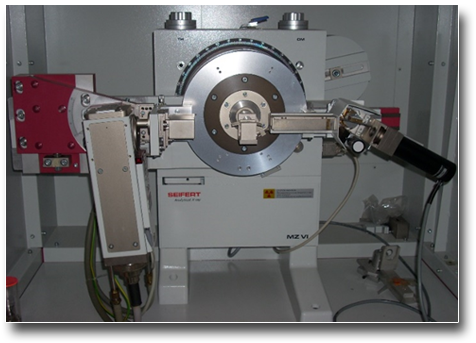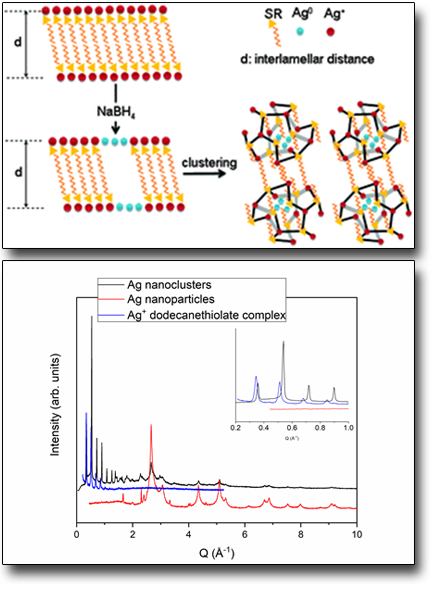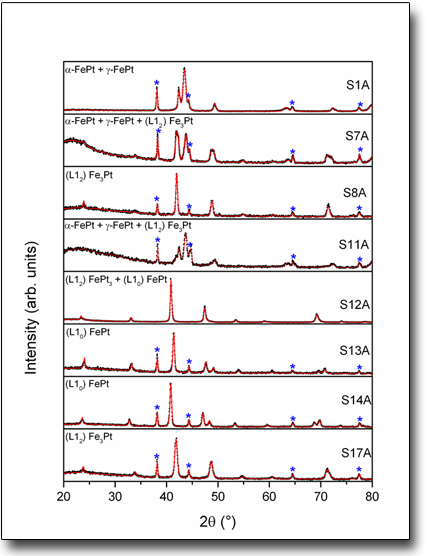
XRD Seifert 3003TT
XRD Seifert 3003P
Patrizia Imperatori - patrizia.imperatori@ism.cnr.it
Laboratory RX
nλ = 2 dsin Θ
where n is an integer (1, 2, 3, ...), λ is the wavelength of the incident x-ray wave, d the lattice plane spacing andΘ the angle of incidence and reflection to the planes. Since every crystalline phase has a characteristic set of lattice spacings, the phases present in the specimen can be identified.
TECHNICAL SPCIFICATIONS
Seifert XRD 3003 TT
-
Two circle goniometer in symmetrical or asymmetrical Theta-Theta configuration. Angle scans are perfomed by X-ray source and detector (Theta-Theta scans), with the sample fixed in horizontal position. The reproducibility is ±0.0003°.
-
The diffractometer is equipped with a thin film attachment, consisting of long Soller slits and a flat graphite monochromator, for grazing incidence measurements.
-
NaI scintillation counter.
-
Cu Kα radiation (λ = 1.5418 Å)
-
Two circle goniometer in the Bragg-Brentano geometry, with a secondary curved graphite monochromator.
-
Cu-ka radiation (λ = 1.5418 Å) is employed..
-
Coupled or independent Omega/2Theta scans are possible.
-
A carousel with 12 sample-holders allows a sequence of measurements.
-
NaI scintillation counter.
-
Rayflex commercial software
AVAILABLE TECHNIQUES
- Normal and grazing incidence X-ray diffraction from polycrystalline powders and films.
- Qualitative and quantitative phase analysis.
- Structural and microstructural analysis: lattice parameters, crystallite sizes, microstrain, texture.
- Rietveld refinements.
- ab-initio methods to solve structures.
SAMPLE
-
Crystalline powders and films
USE FOR
-
Metals
-
Semiconductors
-
Alloys
-
Catalysis
-
Pharmaceuticals
-
Cultural heritages
Case Studies
Nanocluster superstructures or nanoparticles?
The self-consuming scaffold decides
We show that using the same reaction procedure, by hindering or allowing the formation of a reaction intermediate, the Ag+dodecanethiolate polymeric complex, it is possible to selectively obtain Ag dodecanethiolate nanoparticles or Ag dodecanethiolate nanoclusters.
The XRD patterns of the nanoclusters present a sequence of equally spaced low angles peaks, which indicate the presence of a lamellar structure. The presence of low-angle peaks has been attributed to a cluster superlattice, whose d spacing is smaller than that of the corresponding pristine Ag+ thiolate complex, probably due to interdigitation.
The superstructure influences the chemical–physical properties such as luminescence in both the UV and NIR regions or the conductivity.
See: L. Suber, P. Imperatori et al., Nanoscale 10, 7472 (2018).


Tuning hard and soft magnetic FePt nanocomposites
Nanocomposites formed by hard and soft magnetic phases are very promising for magnetic energy storage and biomedical applications. Mainly depending on Fe:Pt atomic ratio, multi-phase or single phase FePt nanocomposites have been prepared by thermal treatment of core shell FePt(Ag)@Fe3O4 nanoparticles at 750°C for 1 h under flow of a Ar + 5% H2 gas mixture.2.
Performing Rietveld refinement of the XRD data the different phases have been singled out.
Besides single phase hard L10 FePt
and soft magnetic L12 2 Fe3Pt nanoparticles;
two phase soft α-FePt and ɣ-FePt
and hard and soft magnetic L10 FePt and soft L12 FePt3.
Nanocomposites have been formed and the structure and morphology correlated to their magnetic behavior.
See: L. Suber, P. Imperatori et al., J. Alloys Comp. 663, 601 (2016).

 English (UK)
English (UK)  Italiano (Italia)
Italiano (Italia)